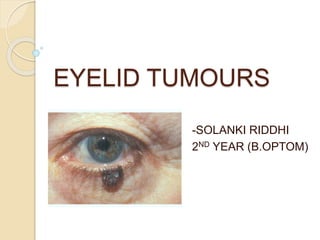
Eyelid tumours
- 1. EYELID TUMOURS -SOLANKI RIDDHI 2ND YEAR (B.OPTOM)
- 2. Almost all types of tumours arising from the skin, connective tissue, glandular tissue, blood vessels, nerves & muscles can involve the lids. A few common tumours are listed here.
- 3. CLASSIFICATION 1. BENIGN TUMOURS 1. Papillomas 2. Xanthelasma 3. Haemangioma 4. Neurofibroma 2. MALIGNANT TUMOURS 1. Basal-cell Carcinoma 2. Squamous cell Carcinoma 3. Sebaceous Gland Carcinoma 4. Malignant Melanoma (Melanocarcinoma)
- 4. 1. BENIGN TUMOURS 1. Papillomas: These are the most common benign tumours arising from the surface epithelium. i. Squamous papillomas occur in adults, as very slow growing or stationary, raspberry- like growths or as a pedunculate lesion, usually involving the lid margin. ii. Seborrhoeic keratosis occurs in middle- aged & older persons. Their surface is friable, verrucous & slightly pigmented. TREATMENT: Simple excision.
- 7. 2. Xanthelasma: These are creamy-yellow plaque-like lesions which frequently involve the skin of upper & lower lids near the inner canthus. Xanthelasma represents lipid deposits in histiocytes in the dermis of the lid. These may be associated with diabetes mellitus or high cholesterol levels. TREATMENT: Excision may be advised for cosmetic reasons; but recurrences are common.
- 8. XANTHELASMA
- 9. 3. Haemangioma: Haemangiomas of the lids are common tumours. i. Capillary haemangioma: Is the most common variety which occurs at or shortly after birth, often grows rapidly & in many cases resolves spontaneously by the age of 7 years. These may be superficial & bright red in colour or deep & bluish or violet in colour. They consists of proliferating capillaries & endothelial cells. TREATMENT: Excision, Intralesional steroid, Superficial radiotherapy.
- 11. ii. Naevus flammeus (port wine stain): It may occur side-by-side or more commonly as a part of Sturge-Weber syndrome. It consists of dilated vascular channels & does not grow or regress like the capillary haemangioma. iii. Cavernous haemangioma: Are developmental & usually occur after first decade of life. It consists of large endothelium-lined vascular channels & usually does not show any regression.
- 12. NAEVUS FLAMMEUS
- 14. 4. Neurofibroma: Lids & orbits are commonly affected in neurofibromatosis (von Recklinghausen’s disease). The tumour is usually plexiform type.
- 15. NEUROFIBROMA
- 16. 2. MALIGNANT TUMOURS 1. Basal-cell Carcinoma: It is the commonest malignant tumour of the lids (90%) usually seen in elderly people. It is locally malignant & involves most commonly lower lid (50%) followed by medial canthus (25%), upper lid (10-15%) & outer canthus (5-10%). TREATMENT: Surgery, Radiotherapy & Cryotherapy.
- 17. CLINICAL FEATURES OF BASAL- CELL CARCINOMA It may present in four forms: Noduloulcerative basal cell carcinoma is the most common presentation. It starts as a small nodule which undergoes central ulceration with pearly rolled margins. The tumour grows by burrowing & destroying the tissues locally like a rodent & hence the name rodent ulcer. Other rare presentations include: non- ulcerated nodular form, sclerosing or morphea type & pigmented basal cell
- 19. 2. Squamous cell Carcinoma: It forms the second commonest malignant tumour of the lid. Its incidence (5%) is much less than the basal cell carcinoma. It commonly arises from the lid margin (mucocutaneous junction) in elderly patients. Affects upper & lower lids equally. TREATMENT: Treatment on the lines of basal cell carcinoma.
- 20. CLINICAL FEATURES OF SQUAMOUS CELL CARCINOMA It may present in two forms: An ulcerated growth with elevated & indurated margins is the common presentation. The second form, fungating or polypoid verrucous lesion without ulceration, is a rare presentation. Metastasis: It metastatises in preauricular & sub-mandibular lymph nodes.
- 22. 3. Sebaceous gland Carcinoma: It is a rare tumour arising from the meibomian glands. TREATMENT: Surgical excision with reconstruction of lids; recurrences are common. CLINICAL FEATURES: It usually presents initially as a nodule (which may be mistaken for a chalazion). Which then grows to form a big growth. Rarely, a diffuse tumour along the lid margin may be mistaken as chronic blepharitis.
- 24. 4. Malignant Melanoma (Melanocarcinoma): It is a rare tumour of the lid (less than 1% of all eyelid lesions). It may arise from a pre-existing naevus, but usually arises from the beginning from the melanocytes present in the skin. TREATMENT: Surgical excision with reconstruction of lid.
- 25. CLINICAL FEATURES OF MALIGNANT MELANOMA (MELANOCARCINOMA): It often appears as a flat or slightly elevated naevus which has variegated pigmentation & irregular borders. It may ulcerate & bleed. Metastasis: The tumour spreads locally as well as to distant sites by lymphatics & blood stream.